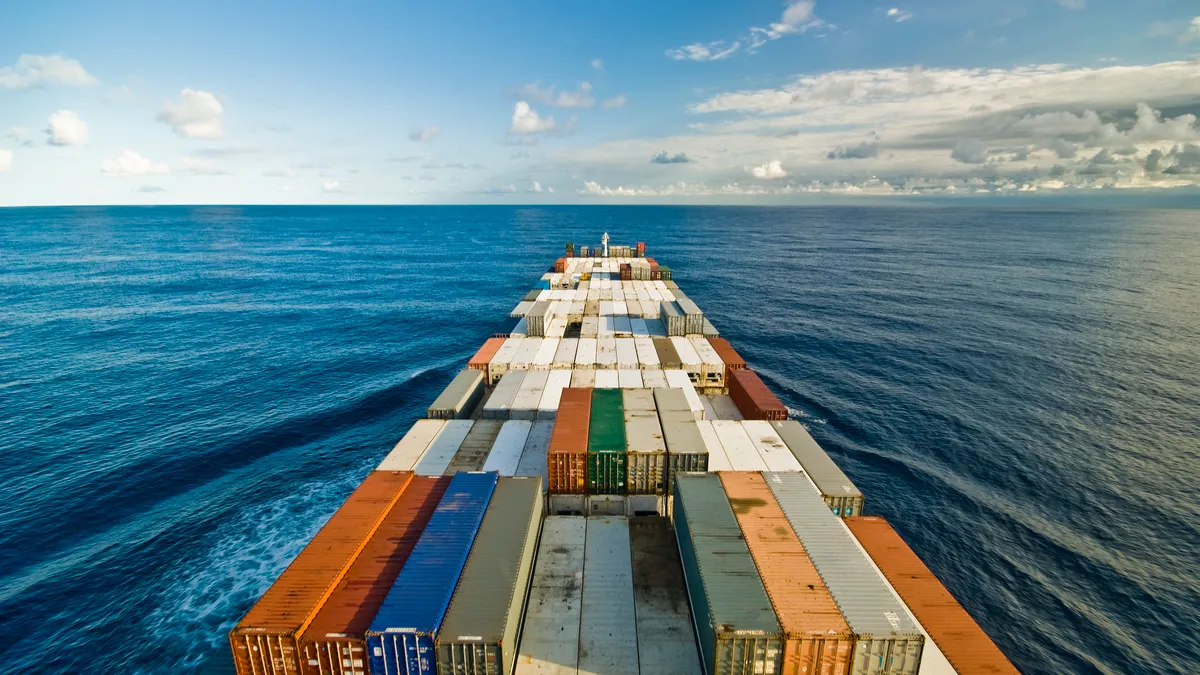Dive Brief:
- Ocean rates continue to surge on the Transpacific route. They are up more than 50% YoY from China and East Asia to the North American East Coast, and have more than doubled (up 145% YoY) from China and East Asia to the North American West Coast, according to numbers from Freightos.
- Container lines are seeing financial gains as rates surge past previous high watermarks. While volume declined across carriers in the second quarter, nearly all of them have higher rates YoY and had record earnings for the quarter, according to Sea-Intelligence.
- But the days of continually rising rates could be in the rearview mirror. The China Ministry of Communications has reportedly requested that carriers not increase China-to-U.S. spot rates again, and COSCO has already canceled a planned uptick, according to a LinkedIn post by the CEO of Zest Shipping Media.
Dive Insight:
After months of canceled sailings, carriers have reinstated capacity and are telling shippers there's simply no room. Ships are completely booked through September and are fairly full through October.
"The recovery in container shipping seen since April should continue during the third quarter of 2020 for most routes, driven by faster recovery in the consumption of goods than of services, the growth of e-commerce, and usual seasonality," CMA CGM wrote in its earnings release. "These factors recently drove freight rates to historically high levels, in particular on transpacific routes where the Group is the world leader."
Christian Pedersen, the regional head of ocean management for Maersk North America, confirmed in an emailed statement that the carrier has reactivated capacity and eliminated blank sailings.
"Equipment shortage is most severe for 40’s and particular 40’ high cubes, so all customers who can convert their cargo to 20’s or [non-operating refrigerated containers] can more easily secure capacity," Pedersen said, referring to the process of loading dry cargo in reefer containers.
The dramatic upswing in prices has led to questions around the pricing model for ocean freight. "Are Ocean Freight Prices Absolutely Broken?" Freightos asked in a blog post earlier this week, which concluded that poor demand visibility resulted in carriers keeping capacity pulled for too long. But it's hard to fault the carriers when demand has been so fickle, according to Gene Graves, executive director of United Shippers Alliance.
"Nobody's told me they saw it coming," Graves said of his conversations with carriers. "I certainly didn't see it coming."
The current environment has also been challenging for shippers, many of whom struggle to find space, Graves said.
The demand swell is the result of three streams of volume meeting at the same time, which, combined, "became a tsunami," he said:
- Peak-season shipping.
- Personal protective equipment shipments coming from Asia.
- Shippers restocking inventory after slowing procurement during shutdowns.
An early estimate from the Port of Los Angeles puts August volume at more than 900,000 TEUs, which would show growth compared to the same month last year.
"This is the worst I've ever seen in my 43 years of international transportation," Graves said. "Up until July 2020, I've never had any issues securing space. It may not be next vessel out, but it does ship in a reasonable amount of time. That all changed in August. And it has been a nightmare, August, and ... September is actually going to be worse."
Carriers reinstating capacity have turned to charter ships, and now every ship in the charter market is in service. "Supply is maxed out," he said. "And demand keeps going."
One carrier told Graves its ship was 300% overbooked. Some carriers are no longer honoring minimum quantity commitments in contracts, and rolled cargo has been an issue for shippers since July.
Higher shipping costs are a strain on some of Graves' members, which are already struggling from the economic downturn and pandemic-related shutdowns.
"Two of our small members say they may not survive all this," he said. "So, it's kind of kicking them when they're down with these prices."
In negotiations, carrier pricing teams have a pretty clear picture on rates for the remainder of 2020, but "they have no clue what 2021 is gonna look like," Graves said.
When Graves asks carriers when his members can expect rates to fall, the carriers say it could be anywhere from the middle of October to end of the year.
"For the time being, demand seems to remain very strong through November from Asia Pacific, and possible leading all the way through to traditional Chinese New Year rush in January," Pedersen said.
Maersk is currently working to move empties back to Asia to ensure all ships are operating at full capacity and working with partners to increase truck capacity at high volume ports, including the ports at Los Angeles and Long Beach, he said.
Airfreight from Asia is also backed up, Graves said, and finding alternative suppliers in North America is not always a short-term option depending on the business.
"The supply chain is just jammed," he said.
This story was updated with comment from Christian Pedersen, the regional head of ocean management for Maersk North America.














